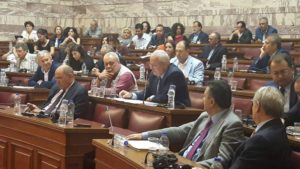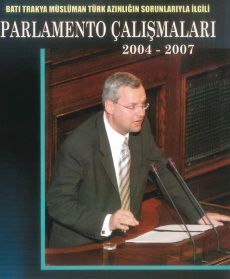PARLIAMENTARY QUESTION TO THE EUROPIAN COMISSION / BASMAS

PARLIAMENTARY QUESTION TO THE EUROPIAN COMISSION / BASMAS
The Region of the Eastern Macedonia and Thrace is located in the north part of Greece. It has an exceptional geostrategic, economic and developmental value, with great competitive advantages.
It has external border of about 350 kilometers with Bulgaria and 200 kilometers with Turkey with extensive unexploited fantastic beaches, two magnificent islands, Thassos and Samothraki, ski resort, “virgin” (old-growth) forests, 400.000 hectares of farmland.
Until 3-4 years before, the Greek-Bulgarian border was closed for 65 years in the context of the cold war and at the same time experiencing the occasional tensions in the East. So, as a result, this exclusion and isolation condition kept this region in slow growth until the recent crisis.
It is also the exit of the eastern Balkans to the Aegean and to the Mediterranean Sea, also a piece of land that connects the East with the West, Asia with Europe, and is crossed by a modern motorway called the Egnatia Road.
Also, it has high culture contribution to the world’s history and culture, and a strong tradition. Produces Mediterranean products and other products of great demand!
It is the runway of energy pipelines with two ports, the port of Kavala and the port of Alexandroupolis, which are development gateways with great potential to the Balkan and to the European hinterland.
Unfortunately, the deep crisis in Greece slowed significantly all sectors of the regional economy and it fully degraded the processing. From 2010 onwards, it is marked as the idling Region, with the characteristic of a structural inertia. During the crisis, the Region of Eastern Macedonia – Thrace shows regression more than any other region in Greece. In 2013, according to Eurostat’s data, it is recorded as the region with the lowest GDP per capita in Greece.
Despite a slight but temporary improvement in 2009 and 2010, which was probably due to the fall of the average resulted of the accession of the countries with a lower development level, and not because of a real increase of productivity and growth of the regional economy, the Region of Eastern Macedonia – Thrace, throughout the period 2000-2013, hasn’t been able to exceed the 75% of the average of the European Union. Also, in the ranking of EU Regions in terms of per capita regional GDP, it has been for a along time in the last places.
According to the figures from Eurostat, in 2014 the GDP per capita of the Region of Eastern Macedonia – Thrace, amounted to € 11,200 and was equivalent to the 41% of the average of EU – 28 (Greece 59% of the average of EU – 28), which classified the region to be the last Region in the Country. This is mainly due to the low economic growth rates that (eg. In the decade 2000-2009) raged from -1% to 11% and at an average of 5%, when the corresponding rates for the country was average 6%, 9% for Attica and 6% for South Aegean and the Ionian Islands.
At the same time, the Regional Units participate unequally in the formation of the regional GDP, a phenomenon which has been exacerbated in recent years.
On the other hand, the participation of the Eastern Macedonia – Thrace in the field of exports is considered quite important in that, this field is almost proportional to the population of the Region and it is compared with the expected dominance of the two larger, metropolitan Regions of the country. The most significant market is Turkey.
Moreover, the impact of the twin crisis, economic and financial crisis in all fields is obvious. While all the social cohesion indicators, in the period 1999-2008 presented a positive course, after 2008, this trend reversed sharply and the indicators tend to return to the levels of 1997. In 2009, the year of economic recession in the country, a significant drop in investments is observed in the region, in all areas.
In the Region of Eastern Macedonia – Thrace, the structural problems have not yet been addressed systematically, and despite the policies implemented in the past, inequities persist, while poverty and unemployment are growing, especially after 2008.
The impacts of the financial crisis are reflected in the loss of 37,500 jobs over the period 2009-2015 (Eurostat)with the secondary sector recording the largest decrease (30.6%) and an increase in the unemployment rate from 14.5% in 2010 to 24,7% in 2014, with greater intensity in young people (50.7% in2014). At the same time, the employment rate in the Region of Eastern Macedonia – Thrace (49.8% in 2014 for ages 15-64) continues to be lower than both the European and the National average (64.8% and 49.4% respectively) and is especially low among young people (up to 24 years). In fact, in the fourth quarter of 2015, in the Region of Eastern Macedonia – Thrace, high unemployment of 22.7%, with greater intensity in young people, who are about 50.7% (2014) and acute social problems like migration, poverty and business closures are recorded.
But because of the high unemployment, the worrying talent drain phenomenon (brain drain) also intensifies, as more and more young scientists leave the Region of Eastern Macedonia – Thrace in order to seek employment opportunities overseas, in places of high quality. Thus, by this leaving, the Region of Eastern Macedonia – Thrace loses enormous resources, and the human resources needed for rectification and exit from the crisis also are drained.
The primary sector is of great importance for the Region of Eastern Macedonia – Thrace as yet employs a significant percentage of the population, and is directly linked to the general geographical features, covering the majority of the land.
Here are the main problems / needs:
- Organizational deconstruction of the Primary sector and lack of cooperative schemes – business clusters per product or per industry, through the action of which the production cost could significantly be reduced.
- Poor link between primary agricultural production and the local processing and research.
- Weak collective schemes of certification, supply, promoting products, and reinforcing the extroversion of the sector and the small bargaining power of producers.
- Shortfall in new crops.
- Low percentage of irrigable agricultural land, from surface waters.
- Aging of the rural population and insufficient training in general. Lack of training structures and counseling.
- Small size of agricultural holdings (farms) and land fragmentation, elements that have significant negative effects on production costs and completion difficulties of consolidations (Lack of credit, land surveying, etc.)
- Difficulty in finding agricultural land for young farmers.
- The absence of a plan and a management policy of agricultural land and livestock farming, with consequent lack of planning agricultural and livestock farming areas, in accordance with the specific production capacity of each area.
- The spread of animal diseases, zoonoses (diseases that can be transmitted to humans), and the emergence of new exotic diseases in livestock in recent years has led to a reduction of the Livestock and farmers leaving the profession.
- The composition of the sectors demonstrates that the region highly depends on the primary sector, which employs 30.6% of workers, while the employment in the secondary sector is 14.7% and in the tertiary is 54.7%. In terms of employment, there are significant differences between the Regional Units.
- The unemployment rate in the Region is about 25%, slightly lower than the national average and significantly higher than the average of EU-28 (10.42%).
- The primary sector remains as a major source of employment, with the agricultural – livestock sector being the largest industry from all the others- so that the region can be described as “mainly agricultural”
The main problems / needs identified are:
- Low participation in the labor market and in the long term high unemployment.
- Reduced employment in the secondary sector.
- High rates in youth unemployment.
- Uneven development of regions and unequal working conditions.
- Timelessly reduced profitability and competitiveness of the local agricultural economy and industry.
In the Region of Eastern Macedonia – Thrace the basic family income, according to the latest available Eurostat data, amounts to €8.700, the lowest in the Territory (throughout the Country), and reaches 77% of the average of the basic family income at national level. In the EU the average of the annual family income is €18.750 which brings Greece to 60.26% of the European average and the Region of Eastern Macedonia – Thrace to only 46.4%.
The objective for the primary production of the Region of Eastern Macedonia – Thrace is, to stop fighting for its survival through individual, unstructured, unconnected efforts and to move to a structured, horizontally and vertically networked production, with all the required support for the strengthening of values and competition, which will have the potential to acquire the necessary technological and manufacturing tools and means, and to use innovation, research and entrepreneurship. This shortly means that, the primary production should have a fundamental role in structuring and designing a successful regional development policy.
PARTICULARLY, AS FAR AS THE CULTIVATION OF TOBACCO IN THRACE IS CONCERNED, WE NOTICE THE FOLLOWINGS:
The development of mountainous and disadvantageous rural areas, is essentially a process of regional development.
We need to talk about a total approach to the development of rural areas where the culture, the natural environment have their value, the notion of processing, of improving the quality of life and all these, are joined together in a program. This is the meaning of integrated (comprehensive) development.
We must find a way to make citizens in the Greek region and especially in mountainous and poor parts of the country, to feel that the policies which EU emanates and which are carried to a technical level, are not something distant from them, but these policies concern them, are for them and next to them.
These areas do not only have disadvantages, they have advantages as well. And these must be especially emphasized to them, where citizens feel that they need to find their way into employment from urban centers.
Even if we produce good products in the Greek countryside, if these products do not get locally surplus value, this cannot feed what we all want, and this is the sustainable development.
Therefore, programs and policies in this direction should support initiatives.
AFTER THE ABOVE AND BECAUSE:
- The Region of Eastern Macedonia – Thrace holds the sad privilege of being the poorest region in Greece, since for the financial year 2014 the GDP per capita amounted to 11.200€ which equals to 41% of the average of ΕU-28 ( Greece 59 % of the average of ΕU-28 ) and classified it as the last Region in the Country.
- Tobacco is an export product which helps the extroversion of Greek economy and especially Basmas, which is cultivated in Thrace and is a variety of tobacco used in the blends of cigarettes of the largest companies worldwide, as happened recently with the commercial deal made with PHILIP MORRIS.
- The product of tobacco will no longer grant coupled aid because this product was not included in Article 38, which includes the products that will receive coupled payments.
- Only in Rodopi regional unit, about 6,800 families live exclusively from tobacco cultivation, because this is a monoculture. Note, indeed, that no political leadership to date has made provision for the formation of alternative crops, which will provide a new perspective to stimulate agricultural income of the area concerned.
- If tobacco, which is mostly cultivated in infertile, mountainous and rain-fed lands, will not be subsidized, this will have as a result, not only the extinction just of a cultivation but the extinction of a social group, with any kind of consequences that this can bring to the social balance and to the prosperity of my region.
- In the final negotiations for the new CAP (Common Agricultural Policy) to be applied in the new programming period 2015-2020, the measure of granting coupled aid has planned for the first time since 2008. The aid has been planned to be at a rate of 5% to 15% of the total EU subsidies on products which due to their high socio-economic importance to the region where they grown, require an additional aid in order to remain sustainable and also to avoid their abandonment.
- Unfortunately, in Article 38 regarding the direct payments, tobacco was excluded from the list of eligible products for aid without justification and despite the opposition of the European Parliament.
- Given that tobacco is a product protected by the EU Treaty (Annex 1), the arbitrary exclusion of it from an agricultural policy measure, creates legitimate concerns for such exclusions of the product and of farmers from other policies as well in the future.
- The Proposal of the Evros-Rodopi Tobacco Producers Consortium is for this aid to be allocated from the reverse assets of the B Pillar of the new CAP for Greece which amount to 2.2 billion euros, 3 euros per kilo to enhance the price of tobacco, so that the cultivation of tobacco to continue to be a sustainable and profitable option for farmers in Thrace, for whom tobacco and its cultivation, are a way of life and part of the culture of their societies.
WE ASK YOU:
- A) Are there any possibilities for the indirect aid of the variety of Basma to be paid from the reverse assets of the B Pillar of the new CAP for Greece which amount to 2.2 billion euros, 3 euros per kilo to enhance the price of tobacco, so that the cultivation of tobacco to continue to be a sustainable and profitable option for farmers in Thrace, and tobacco to be maintained as an integral element of the local economy, tradition and culture of Thrace?
- B) Can other ways of recourses be found from the Greek government, in order to grand mountainous and disadvantaged areas producing tobacco, such as Thrace? For example, such as the redistribution of available resources at the rate of 5% of the total budget, in accordance with the new CAP. So that, each member country could give to those areas of its territory whatever they lost when the redistribution took place?



